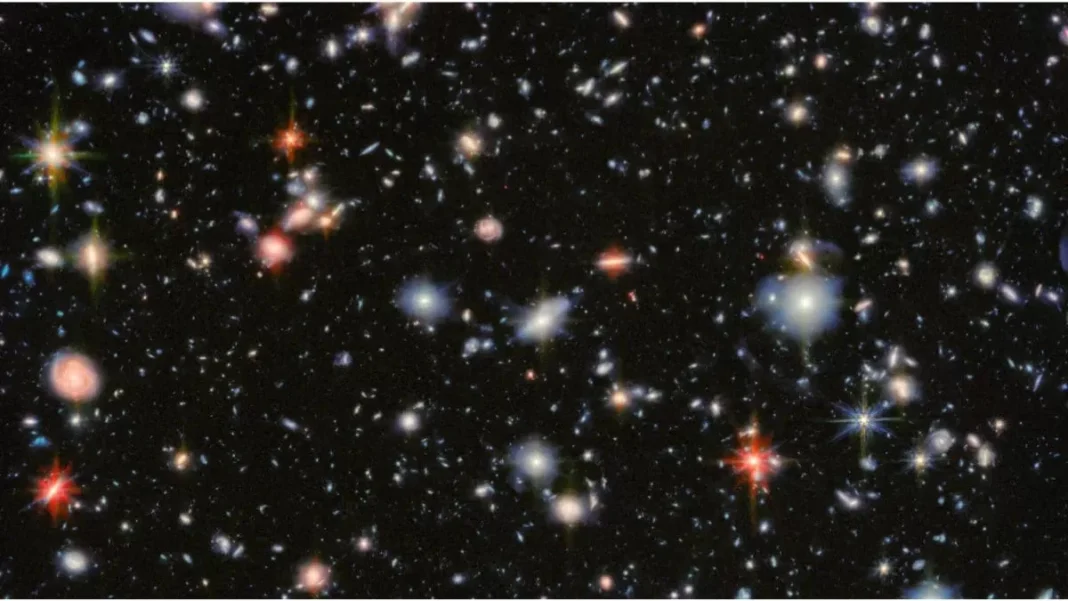The James Webb Space Telescope (JWST) has once again captured our imagination with its latest groundbreaking discovery. In a recent re-imaging of Hubble’s Ultra Deep Field, the telescope has revealed over 2,500 galaxies in stunning infrared detail. This remarkable feat was made possible by the telescope’s powerful NIRCam and MIRI instruments, which have allowed us to peer deeper into the universe than ever before.
The Ultra Deep Field is a small patch of sky in the constellation Fornax, which was first observed by the Hubble Space Telescope in 2003. This area was chosen because it appeared to be empty, but upon closer inspection, Hubble revealed a treasure trove of galaxies, some dating back to just a few hundred million years after the Big Bang. Now, with the help of the JWST, we have been able to delve even deeper into this cosmic wonderland.
The JWST is the most advanced and powerful space telescope ever built. It is a joint project between NASA, the European Space Agency, and the Canadian Space Agency, and is set to launch in 2021. Its primary mission is to study the early universe, and with its state-of-the-art technology, it is expected to revolutionize our understanding of the cosmos.
One of the key objectives of the JWST is to observe the universe in the infrared spectrum, which is invisible to the human eye. This is where the telescope’s NIRCam and MIRI instruments come into play. The Near-Infrared Camera (NIRCam) is designed to capture images of the universe in near-infrared light, while the Mid-Infrared Instrument (MIRI) is specifically designed to study the mid-infrared region. Together, these instruments have allowed us to see the universe in a whole new light.
The latest re-imaging of the Ultra Deep Field is part of the JWST’s JADES (JWST Advanced Deep Extragalactic Survey) survey. This survey aims to study the earliest galaxies in the universe, which are believed to have formed just a few hundred million years after the Big Bang. By observing these galaxies in the infrared spectrum, we can see through the dust and gas that obscures them in visible light, giving us a clearer and more detailed view.
The JADES survey has already produced some remarkable results. In addition to the 2,500 galaxies captured in the Ultra Deep Field, the survey has also produced the deepest mid-infrared image ever taken. This image, which covers an area of 0.2 square degrees, contains over 100,000 galaxies, some of which are so faint that they are barely visible in the image.
But it’s not just about the number of galaxies captured in the image; it’s also about the level of detail that the JWST has been able to reveal. The telescope’s powerful instruments have allowed us to see individual stars within these galaxies, giving us a glimpse into their formation and evolution. This level of detail was simply not possible with previous telescopes, and it opens up a whole new realm of possibilities for future research.
The JADES survey is just the beginning for the JWST. Over the course of its mission, the telescope will continue to observe the universe in unprecedented detail, providing us with a wealth of new information and insights. It will allow us to study the atmospheres of exoplanets, search for signs of life beyond our solar system, and unravel the mysteries of the early universe.
The James Webb Space Telescope is a testament to human ingenuity and our insatiable curiosity about the universe. Its latest discovery in the Ultra Deep Field is a reminder of how much we still have to learn about the cosmos and how much more we can achieve with the right tools. With the JWST, the possibilities are endless, and we can only imagine what other wonders it will reveal in the years to come.


